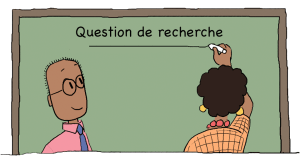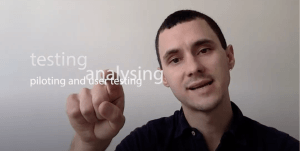
From the french translation of IHC primary school resources.
IHC resources are designed to be adapted
IHC resources are based on teaching IHC Key Concepts. This underlying foundation enables people to tailor the resources for use in their settings, or develop new resources, without losing track of the core learning goals.
Teams in many countries have carried out work adapting or developing IHC resources. Some projects are framed and funded as research. Others are non-research initiatives carried out by enthusiasts. Read about ongoing international work in the IHC annual newsletter.
We welcome collaboration with new people who are interested in translating, adapting, developing, or evaluating resources for use in their settings. We can help you get started. Familiarise yourself with the information below, then contact us.
Contextualising existing resources
Each contextualisation initiative is different. Your teams decides what kind of work best suits your interests, available resources, and needs in your setting. Examples include:
- language translation
- simple adaptation (such as changing names or examples of health conditions)
- more advanced adaption (such as redrawing illustrations or recreating existing content for a different media format)
If you are going to translate and adapt existing resources, you should at minimum plan to include some form of user feedback to make sure the result is understandable and suitable for your target audience. You can also pilot resources (for instance in classrooms) to learn more about how they might be used in real life and improved.
See Guides (detailed guidance for translating and adapting IHC resources)
See Translation and adaptation articles
If you are planning to try to get IHC resources implemented in a curriculum or widely adopted by teachers in your setting, it can be helpful to start by carrying out a context analysis, to gain insight and buy-in from a broad range of stakeholders and explore how the IHC Key Concepts map onto existing curricula.
See example publications: Context analyses to support translation and adaptations

See video: How we work to develop resources
Developing new resources
If you are going to develop new resources instead of adapting existing ones, you’ll want to start by prioritising which IHC Key Concepts to include. You should also consider carrying out a context analysis to learn more about your target audience and the setting where resources will be used.
You will want to plan for rounds of feedback from a range of people. We employ a human-centred design approach to resource development, involving cycles of idea generation, prototyping, stakeholder feedback, and analysis.
See publications: Development of educational resources
Evaluating resources
Some teams have planned or carried out evaluations of contextualised or new resources in their settings, using questions based on the items in the CLAIM Evaluation Tool. This might include:
- validating the CLAIM Evaluation Tool questions in new languages or for new settings/populations
- conducting surveys to measure a population’s ability to understand and use IHC Key Concepts
- conducting randomised trials of educational resources
See: CLAIM Evaluation tool manual
See publications about the Claim Evaluation Tool
- You might need funding for professional translation.
- At minimum, a translation should be proofread by another translator who has knowledge of both the source language and the target language. This might require funding (to hire a second translator).
- We strongly encourage that you get feedback from your target audience(s). Consider if and what kind of reimbursement would be reasonable for collaborators or participators in your context. For instance, if you are engaging with a network of professionals (e.g., teachers, school nurses), they might need to have their hours covered.
- If you carry out group interviews, focus group discussions, or other kinds of workshops, you might need a budget for food, transportation, and possibly overnight stays.
- If there is not capacity on the team to carry out transcriptions of interviews or focus groups, then this might need funding.
- You might decide to carry out a full scale pilot of the resources in a school classroom for a semester. If the class needs to print books or other material (questionnaires, classroom materials), then this will require funds. If the teacher needs to access digital resources in a setting where online browsing is expensive, you will be a budget for this.
No, you will need your own source of financial support or carry out the work on a voluntary basis.
- We don’t know the answer to this question, as it is different for every curriculum.
- Our experience from Uganda, Kenya, Rwanda and Norway is that this project fits well under a combination of natural sciences and different kinds of health/wellbeing-related classes. In some East African pilot schools we saw the materials as also potentially strengthening English language learning.
- Consider carrying out a context analysis to map the curriculum in your setting to the IHC Key Concepts
- You might also contact people who are responsible for curriculum development in your country to find out if there are any curriculum revisions underway.
- Ask some teachers for input.
- See examples of publications reporting curriculum mapping:
- Contextualizing critical thinking about health using digital technology in secondary schools in Kenya: a qualitative analysis.
- Learning to think critically about health using digital technology in Ugandan lower secondary schools: a contextual analysis.
- Teaching critical thinking about health using digital technology in lower secondary schools in Rwanda: A qualitative context analysis.
- Teaching and learning how to make informed health choices: Protocol for a context analysis in Spanish primary schools.
- Teaching critical thinking about health claims: market analysis for Norwegian primary and lower secondary school.
There is potential for broader impact, over and beyond the learning outcomes that have been measured in trials. The following suggestions were drawn from interview and focus group data collected from teachers and students who used the primary or secondary school resources:
- Ability and motivation to think critically about claims that are not about health effects (e.g. novel things may not be better).
- Improved ability to make informed decisions:
- Learning to weigh benefits and harms when making a decision
- Learning to make careful considerations, rather than snap judgments based on what other people do or say
- Becoming more actively involved in decisions about their own or their family’s health care
Additional reported impact:
- Impact on weaker students: In primary school trial in Uganda, although the effect of the intervention was larger for children with better reading skills, it was also shown to be effective for children at lower reading levels.
- Impact on quieter students: There is some indication in the primary and secondary school process evaluations that shyer, quieter students were more outspoken and active when these resources are being used in the classroom.
- Experience of relevance: Students experience use of the resources relevant to their lives and engaging. This could potentially lead to improved attitudes about science, which may be on the decline.
We are currently collecting data on transfer of learning to daily life in ongoing follow-up studies of secondary school resources in East Africa (summer 2023). We are also exploring potential adverse effects. Look at the publications list for these findings when articles become available.
- The primary school comic book and activities were mainly designed and tested with children from 12-13 years old, but that doesn’t mean they aren’t suitable for younger or older children. We think that some of the concepts could be taught successfully to even younger children, and are considering that as a topic of future research.
- There is no reason why primary or secondary school resources could not work with an older audience, except that some people might find a resource “childish” (although we don’t know that for sure. We thought the Norwegian school kids would find the resources “foreign”, but they didn’t indicate that at all.)
- We think Key Concepts ideally being taught over time in a spiral curriculum, where they are taught with increasing degrees of complexity and repetition. Entry-point is determined by what people already know, not by age.
That varies on which resource you are translating and what methods you use. The Spanish team translated the primary school resources, collecting feedback from children, teachers and medical doctors. Their process is documented in the Spanish translation report, and overall the work took six calendar months.
Only if the resulting product is free to use and adapt.
IHC resources are licensed under the following Creative Commons license: Attribution-NonCommercial-ShareAlike 4.0 International (CC BY-NC-SA 4.0). In short, this means you are free to:
- Share — copy and redistribute the material in any medium or format
- Adapt — remix, transform, and build upon the material
However you are not allowed to use or adapt IHC resources for profit:
- NonCommercial — You may not use the material for commercial purposes.
- ShareAlike — If you remix, transform, or build upon the material, you must distribute your contributions under the same license as the original.
